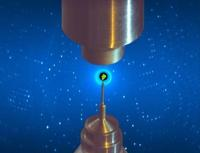Speaker
Description
Triosephosphate isomerase (TIM) is a key enzyme in glycolysis that catalyses the interconversion of glyceraldehyde-3-phosphate (GAP) and dihydroxyacetone phosphate (DHAP). This simple reaction involves the shuttling of protons mediated by protolysable side chains. The catalytic power of TIM is thought to stem from the ability to facilitate the deprotonation of a carbon next to a carbonyl group to generate an enediolate intermediate. The enediolate intermediate is believed to be mimicked by the inhibitor 2-phosphoglycolate (PGA) and the following enediol intermediate by phosphoglycolohydroxamate (PGH). We have determined the neutron structure of Leishmania mexicana TIM with both inhibitors and performed joint neutron-X-ray refinement followed by quantum refinement. The structures show that in the PGA complex, the postulated general base Glu-167 is protonated, while in the PGH complex it remains deprotonated. The deuteron is clearly localized on Glu-167 in the PGA–TIM structure, suggesting an asymmetric hydrogen bond instead of a low-barrier hydrogen bond. The full picture of active site protonation states allows us to investigate the reaction mechanism with density functional theory calculations.

